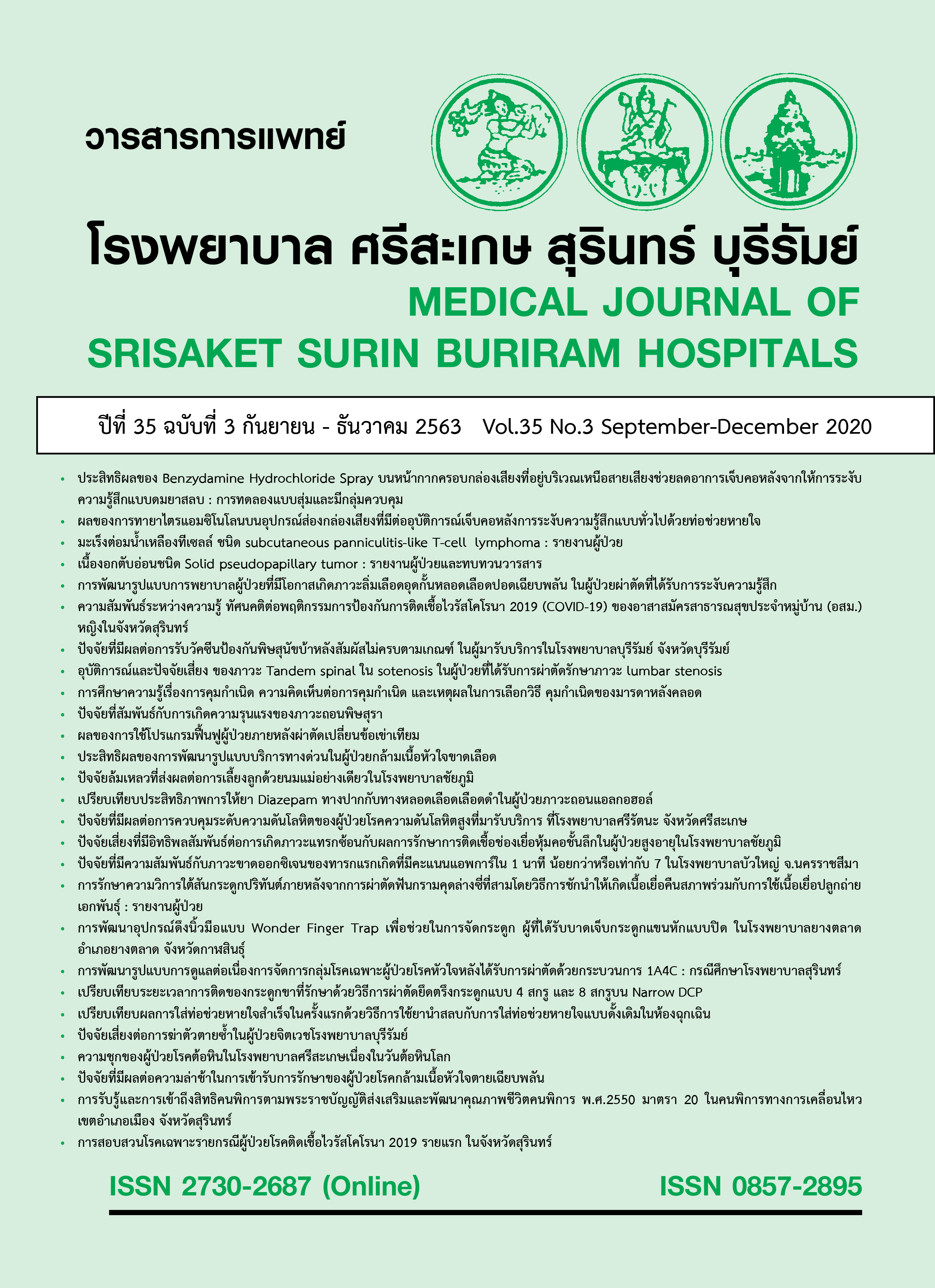ปัจจัยที่สัมพันธ์กับการเกิดความรุนแรงของภาวะถอนพิษสุรา
Main Article Content
บทคัดย่อ
หลักการและเหตุผล : ภาวะถอนพิษสุรารุนแรงเกิดขึ้นเมื่อผู้ป่วยติดสุราหยุดดื่มสุรากะทันหันซึ่งมีความเสี่ยงอาจ ทำให้เสียชีวิตได้ดังนั้นการประเมินปัจจัยที่สัมพันธ์กับการเกิดภาวะถอนพิษสุรารุนแรงจะ ช่วยให้สามารถรักษาคนไข้ได้ดียิ่งขึ้น
วัตถุประสงค์ : เพื่อศึกษาปัจจัยที่สัมพันธ์กับการเกิดภาวะถอนพิษสุรารุนแรง ในโรงพยาบาลสุรินทร์
วิธีการศึกษา : เป็นการศึกษาเชิงพรรณนาแบบเก็บข้อมูลย้อนหลัง (retrospective case-control study) จากบันทึกเวชระเบียนผู้ป่วยในที่วินิจฉัยภาวะถอนพิษสุรา (F10.3, Alcohol withdrawal state) และภาวะถอนพิษสุราระดับรุนแรง (F10.4, Alcohol withdrawal state with delirium) ตามเกณฑ์ ICD10 ที่รักษาตัวในหอผู้ป่วยจิตเวช โรงพยาบาลสุรินทร์ ระหว่าง วันที่ 1 ตุลาคม พ.ศ.2559 ถึง 31 มกราคม พ.ศ.2563 โดยแบ่งผู้ป่วยออกเป็นกลุ่ม 2 กลุ่ม คือ กลุ่มที่มีภาวะถอนพิษสุราระดับรุนแรง (Delirium Tremens; DTs) และภาวะถอนพิษสุรา (non Delirium Tremens; non-DTs) ข้อมูลที่บันทึกประกอบด้วย ได้แก่ อายุ เพศ ระยะเวลาที่ดื่มสุรา ปริมาณสุราที่ดื่มต่อครั้ง ประวัติอาการชักจากการขาดสุรา ระยะเวลา ชองการชาดสุรา ระดับคะแนน AWS แรกรับ คะแนนการติดสุรา (AUDIT) และ เก็บข้อมูล ผลตรวจทางห้องปฏิบัติการได้แก่ ระดับเกลือแรโซเดียมโพแทสเซียม แมกนีเซียม แคลเซียม ระดับเอนไซม์ดับ ALT AST และระดับเกล็ดเลือดวิเคราะห์ข้อมูลโดยใช้สถิติ ได้แก่ ร้อยละ ค่าเฉลี่ย ส่วนเบี่ยงเบนมาตรฐาน logistic regression, adjusted OR และ 95% CI
ผลการศึกษา : ผู้ป่วยที่มิภาวะถอนพิษสุราทั้งหมดเป็นเพศขาย จำนวน 385 คน มีภาวะถอนพิษสุราระดับรุนแรง (DTs) 209 คน (ร้อยละ 54.3) และมีภาวะถอนพิษสุราระดับไม่รุนแรง (non-DTs) 176 คน (ร้อยละ 45.7) ทั้งสองกลุ่มมีอายุเฉลี่ยใกล้เคียงกันและส่วนใหญ่มีภาวะติดสุรา กลุ่ม DTs มีระดับเกลือแรในเลือดได้แก่โซเดียมโพแทสเซียม แมกนีเซียม แคลเซียม และ ระดับเกล็ดเลือด ต่ำกว่ากลุ่ม non-DTs และกลุ่ม DTs มีค่าการทำงานชองเอนไซม์ดับสูง กว่ากลุ่ม non-DTs เมื่อใช้การวิเคราะห์แบบถดถอย (logistic regression) พบว่า ปัจจัยที่มีผลต่อการเกิดภาวะถอนพิษสุรารุนแรง คือ ประวัติเคยชักจากการขาดสุรา (p= 0.022, adjusted OR 0.34, CI: 0.14-0.85) ภาวะแมกนีเซียมในเลือดต่ำ (p=0.001, adjusted OR 0.40, CI: 0.23-0.70) และระดับเอนไซม์ ALT ที่ผิดปกติ (p=0.029, adjusted OR 1.77, CI: 1.06-2.96)
สรุป : การศึกษานี้พบว่าปัจจัยที่มีผลทำให้คนไข้มิภาวะถอนพิษสุรารุนแรง ได้แก่ ประวัติเคยชักจากการขาดสุรา ภาวะแมกนีเซียมในเลือดต่ำ (Flypomagnesemia) และภาวะเอนไซม์ ALT สูง
คำสำคัญ : ถอนพิษสุรารุนแรง เกลือแร่ต่ำ
Article Details
เอกสารอ้างอิง
Sadock BJ, Sadock VA, Ruiz P. Synopsis of psychiatry behavioral sciences, listed. Philadelphia : Wolters Kluwer Health/ Lipplincott; 2016.
สาวิตรี อัษณางค์กรชัย, สุวรรณา อรุณพงศ์ไพศาล. ปัญหาและความผิดปกติจากการดื่มสุรา ความสำคัญ และการดูแลรักษาในประเทศไทย. สงขลา : สหมิตรพัฒนาการพิมพ์; 2557.
Trevisan LA, Boutros N, Petrakis IL, Krystal JH. Complications of alcohol withdrawal : pathophysiological insights. Alcohol Health Res World 1998;22(1):61-6.
Wetterling T, Kanitz RD, Besters B, Fischer D, Zerfass B, John U, et al. A new rating scale for the assessment of the alcohol-withdrawal syndrome (AWS scale). Alcohol Alcohol 1997;32(6):753-60.
เบญจวรรณ จอมอินตา. การพัฒนาแนวปฏิบัติทางคลินิกสำหรับการผูกยึดผู้ป่วยระยะถอนพิษสุรา โรงพยาบาลเกาะคา จังหวัดลำปาง. [การค้นคว้า อิสระปริญญาพยาบาลศาสตรมหาบัณฑิต]. คณะพยาบาลศาสตร์; บัณฑิตวิทยาลัย, เขียงใหม่ : มหาวิทยาลัยเขียงใหม่; 2550.
เทอดศักดิ์ เดชคง, อินทิรา ปัทมินทร, อุษา พึ่งธรรม, ธัญลักษณ์ แก้วเมือง, อภิสิทธิ์ ฤธาทิพย์. คู่มือแนวทางปฏิบัติการดูแลช่วยเหลือและบำบัดผู้ประสบปัญหา แอลกอฮอล์. กรุงเทพฯ : สำนักพัฒนาสุขภาพจิต กรมสุขภาพจิต; 2547.
Chandini S, Sequeira AZ, Mathai PJ. Factors associated with delirium tremens: A retrospective chart study. Muller J Med Sci Res 2013;4:86-9.
Sarkar S, Choudhury S, Ezhumalai G, Konthoujam J. Risk factors for the development of delirium in alcohol dependence syndrome: Clinical and neurobiological implications. Indian J Psychiatry 2017;59(3):300-5.
Palmstierna T. A model for predicting alcohol withdrawal delirium. Psychiatr Serv 2001;52(6):820-3. D
Lee JH, Jang MK, Lee JY, Kim SM, Kim KH, Park JY, et al. Clinical predictors for delirium tremens in alcohol dependence. J Gastroenterol Hepatol 2005;20(12):1833-7.
Fiellin DA, O'Connor PG, Holmboe ES, Horwitz Rl. Risk for delirium tremens in patients with alcohol withdrawal syndrome. Subst Abus 2002;23(2):83-94.
Ferguson JA, Suelzer CJ, Eckert GJ, Zhou XH, Dittus RS. Risk factors for delirium tremens development. J Gen Intern Med 1996;11(7):410-4.
Salottolo K, McGuire E, Mains CW, van Doom EC, Bar-Or D. Occurrence, Predictors, and Prognosis of Alcohol Withdrawal Syndrome and Delirium Tremens Following Traumatic Injury. Crit Care Med 2017;45(5):867-74.
Benedict NJ, Wong A, Cassidy E, Lohr BR, Pizon AF, Smithburger PL, et al. Predictors of resistant alcohol withdrawal (RAW): A retrospective case-control study. Drug Alcohol Depend 2018;192:303-8
Eyer F, Schuster T, Felgenhauer N, Pfab R, strubel T, Saugel B, et al. Risk assessment of moderate to severe alcohol withdrawal-predictors for seizures and delirium tremens in the course of withdrawal. Alcohol Alcohol 2011;46(4):427-33.
Borah AJ, Deka K, Bhattacharyya K. Serum electrolytes and hepatic enzymes level in alcohol withdrawal patients with and without delirium tremens-a comparative study. Int J Health Sci Res 2017;7(11):74-83.
มงคล ศิริเทพทวี, อัญชลี ศิริเทพทวี, ศิริภรณ์ ชัยศรี, บุษกร วรากรอมรเดช, เมษา สุวรรณรัง, สวัสดิ์ เที่ยงธรรม. ความไม่สมดุลของเกลือแร่แมกนีเซียมในผู้ป่วยที่มีภาวะถอนพิษสุรา. วารสารสถาบันจิตเวชศาสตร์สมเด็จเจ้าพระยา 2015;9(2);36-48.
Berggren U, Fahlke C, Berglund KJ, Blennow K, Zetterberg H, Balldin J. Thrombocytopenia in early alcohol withdrawal is associated with development of delirium tremens or seizures. Alcohol Alcohol 2009;44(4):382-6.
Elisaf M, Liberopoulos E, Bairaktari E, Siamopoulos K. Hypokalaemia in alcoholic patients. Drug Alcohol Rev 2002;21(1):73-6.
Stasiukyniene V. [Blood plasma potassium, sodium and magnesium levels in chronic alcoholism during alcohol withdrawal] [Article in Lithuanian] Medicina (Kaunas) 2002;38(9):892-5.
กองสถิติสังคม สำนักงานสถิติแห่งชาติ. การสำรวจ พฤติกรรมการสูบบุหรี่และการดื่มสุราของประชากร พ.ศ. 2560. กรุงเทพฯ : บริษัทพิมพ์ดีการพิมพ์ จำกัด; 2561
World Health Organization. The ICD-10 Classification of Mental and Behavioural Disorders : Clinical descriptions and diagnostic guidelines. Geneva: Division of Mental Health World Health Organization; 1992.
พันธุนภา กิตติรัตนไพบูลย์, บรรณาธิการ. คู่มือสำหรับผู้อบรม : การดูแลผู้มืปัญหาการดื่มสุราเบื้องต้นสำหรับบุคลากรสุขภาพ ฉบับปรับปรุง 2554 : Module C-มาตรการที่ 2: มาตรการบำบัดรักษาภาวะถอนพิษสุรา. พิมพ์ครั้งที่ 3. เชียงใหม่ : แผนงานการพัฒนาระบบการดูแลผู้มีปัญหาการดื่มสุรา โรงพยาบาลสวนปรุง; 2555.
Saunders JB, Aasland OG, Babor TF, de la Fuente JR, Grant M. Development of the Alcohol Use Disorders Identification Test (AUDIT): WHO Collaborative Project on Early Detection of Persons with Harmful Alcohol Consumption—II. Addiction 1993;88(6):791-804.
Monte R, Rabunal R, Casariego E, Bal M, Pertega S. Risk factors for delirium tremens in patients with alcohol withdrawal syndrome in a hospital setting. Eur J Intern Med 2009;20(7):690-4.
Kadajari A, Kumar NP, Raju TSN, Rani SR. Predictors of Complicated Withdrawal in Patients with Alcohol Dependence Syndrome. IOSR-JDMS 2019;18(6):11-9.
Rogawski MA. Update on the neurobiology of alcohol withdrawal seizures. Epilepsy Curr 2005;5(6):225-30.
Ahmed F, Mohammed A. Magnesium: The Forgotten Electrolyte-A Review on Hypomagnesemia. Med Sci (Basel) 2019;7(4):56.
Harshe DG, Thadasare H, Karia SB, De Sousa A, Cholera RM, Kale SS, et al. A study of Patterns of Platelet Counts in Alcohol Withdrawal. Indian J Psychol Med 2017;39(4):441-4.


